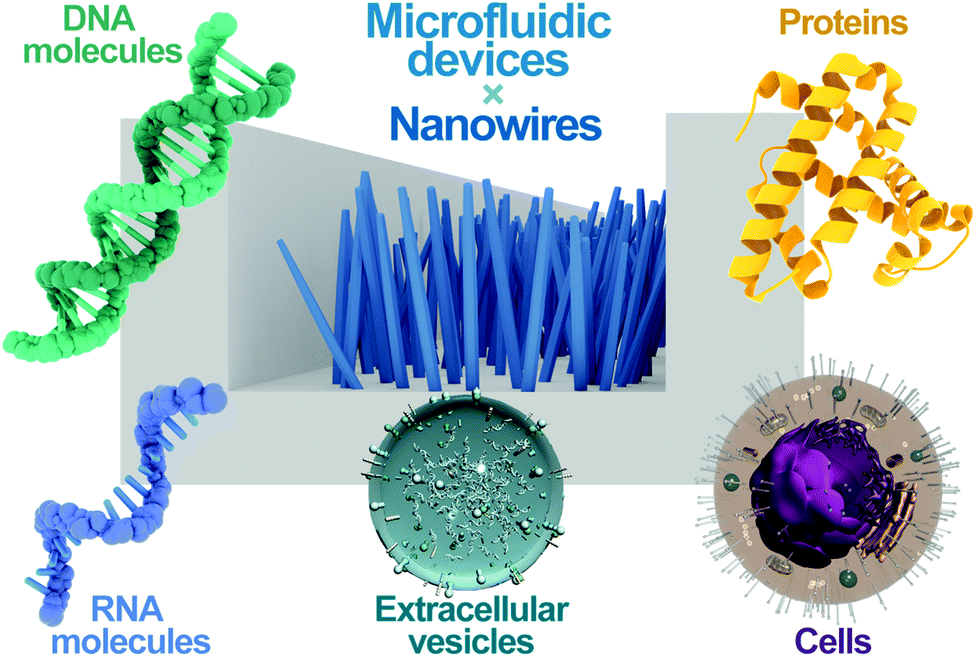With the introduction of synthetic nanomaterials, groundbreaking research in nanotechnology has led to tremendous improvement in biomolecular analysis during the last decade. Novel research involving nanowire oxides as an analytical method for liquid biopsy has been reported in the journal Chemical Communications.

Study: Oxide nanowire microfluidics addressing previously-unattainable analytical methods for biomolecules towards liquid biopsy. Image Credit: Billion Photos/Shutterstock.com
Studying biomolecules has significantly impacted our knowledge of the molecular pathways that underpin human well-being and disease. The ability to study biomolecules is predicted to make molecular fingerprints a powerful tool for illness diagnosis.
Considering biomolecular analysis is mainly determined by biomolecule properties, a sensitive approach to overcoming existing problems and opening up new research fronts is a vital. Due to their distinctive attributes and forms, nanostructures created utilizing self-assembly and nanofabrication methods are predicted to be used in bioanalytical domains.

An overview of bioanalytical methods using nanowire microfluidic devices. The combination of nanowires and microfluidic devices enables the analysis of DNA molecules, RNA molecules, proteins, extracellular vesicles, and cells. Image Credit: Takahashi, H., et al
Nanowire Microfluids Applications
Nanowire microfluidics have unique features that ensure their potential for a broad range of industries. Current efforts have involved working on the manufacture of nanowire microfluidic devices as well as the creation of biomolecular analytical methods based on the devices' unique features.
Nanowires have received a lot of attention in bioanalytical and biotechnological applications because of their small regime levels that are comparable to biomolecules with a larger specific surface area ratio, which are both important criteria in reaching high levels of sensitivity.
Apart from nanowire-based detectors, there are numerous nanowires utilized as biotechnological and biomedical tools, owing to their ability to directly interact with biomolecules.
The very first cell-penetrating nanowire arrays for delivering genes, for example, demonstrated that nanowires might be used to carry genes into living mammalian stem cells cultivated on nanowires. These cells were also reported to have a survival rate of up to one week.
Several studies have found that the characteristics of EV-encapsulated miRNAs using nanowires are essential in cell transmission and epigenetic regulation, making them a promising novel liquid biopsy source. The device's efficiency is due to the nanowire characteristics along with their structural strength, which is permanently affixed into the adsorbent and undeterred by buffer flow. The electrostatic collection is also unaffected, allowing negatively charged EVs to be collected more efficiently than standard techniques.
Antimicrobial resistance from genetic material, pathogen medical testing, and microbial functional genomics from single microbes were all investigated in these works.

(a) Annealed ZnO/Al2O3 core/shell nanowires were developed as a platform for capturing RNA molecules.51 (b) Characterization of the annealed ZnO/Al2O3 core/shell nanowires by scanning electron microscopy (SEM; first row left), transmission electron microscopy (TEM; first row right and second row left), X-ray diffraction (second row right), and TEM-energy dispersive X-ray spectroscopy (third and fourth rows).51 Image Credit: Takahashi, H., et al
DNA Separation for Liquid Biopsy Using Nanowire Microfluids
In the biomolecular field, separating biomolecules from a complicated mixture is a critical starting point for understanding the biological mechanisms of individual biomolecule functions. Considering the success of nanotechnology with nanopillar and nanowall array for DNA separation, a method to attain the desired size range and build 3D tailored spatial nanostructures had remained problematic.
As a result of the easy manufacturing control for required size and geometric characteristics, nanowire arrays have arisen as an alternative nanostructure. Furthermore, the nanowires' thin shape is advantageous for DNA separation because it can efficiently elongate DNA molecules with low bending distortion. Researchers built a SnO2 nanowire spot-array for DNA modification and separation as one of our first attempts to investigate nanowire arrays.
Application of Nanowire Detection for Liquid Biopsy
The capacity to identify biomolecules is crucial for the accurate diagnosis and treatment of malignancies and infectious disorders. Molecular biomarkers are one-of-a-kind illness indicators that have long been recognized for their ability to provide genetic information from the earliest stages of a disease to its last stages, paving the way for customized therapy and care. Nonetheless, biomolecule identification is mostly determined by their properties, which are seldom seen in biological materials.

(a) Schematic of DNA extraction in microbial cells. The adsorbed cells on nanowires are ruptured by nanowire-entanglement and membrane stretching.63 (b–d) Schematic diagram of the moment of DNA extraction via nanowire-entanglement, and snapshots of fluorescence images of DNA extraction from B. subtilis and E. coli.63 Image Credit: Takahashi, H., et al
Due to the larger specific surface area to volume ratio of the new nanowires technology, 3D nanostructures encapsulated with particular antibodies were able to detect tumor cells more efficiently. A polymeric nanowire system was also found to be excellent for biomolecule capturing and release using a simple electrochemical technique. These nanowire systems demonstrated increased biomolecule capture efficiency, allowing for high sensitivity and precise identification.
Research Development on Upcoming Years
Further commercialization of liquid biopsy for many illnesses, including cancer, will be accomplished when nanowire devices have been developed. Biomolecules in bodily fluids will be used as diagnostic markers.
Developments in the extraction, separation and detection methods for illnesses related to biomolecules and further breakthroughs in nanowire detectors for combinatorial detection of biological molecules such as proteins and nucleic acids are likely to develop in the upcoming years.
Continue reading: Nanotechnology and Biotechnology - Similarities and Differences.
Reference
Takahashi, H., et al. (2021). Oxide nanowire microfluidics addressing previously-unattainable analytical methods for biomolecules towards liquid biopsy. Royal Society of Chemistry. DOI: 10.1039/D1CC05096F
Disclaimer: The views expressed here are those of the author expressed in their private capacity and do not necessarily represent the views of AZoM.com Limited T/A AZoNetwork the owner and operator of this website. This disclaimer forms part of the Terms and conditions of use of this website.